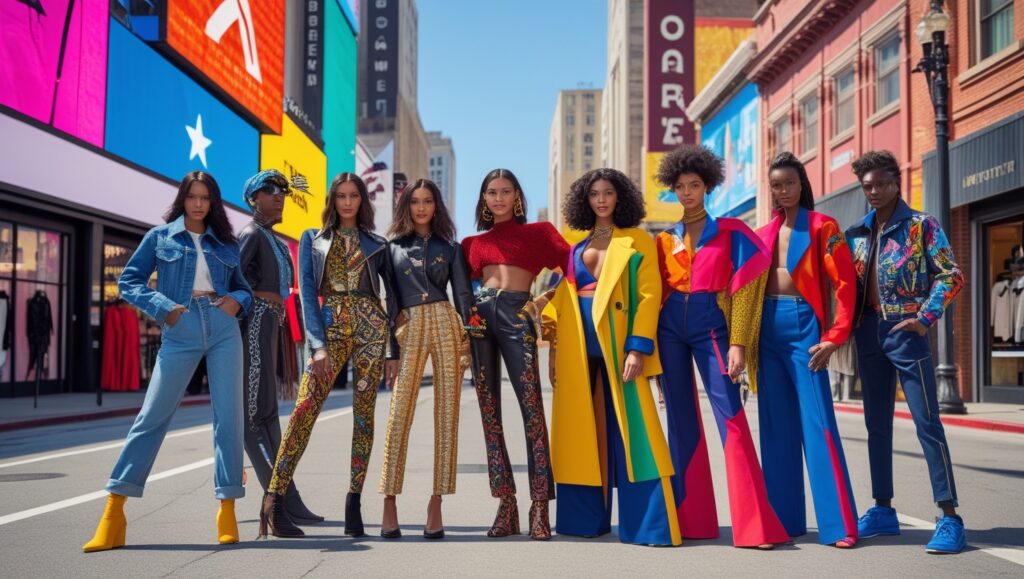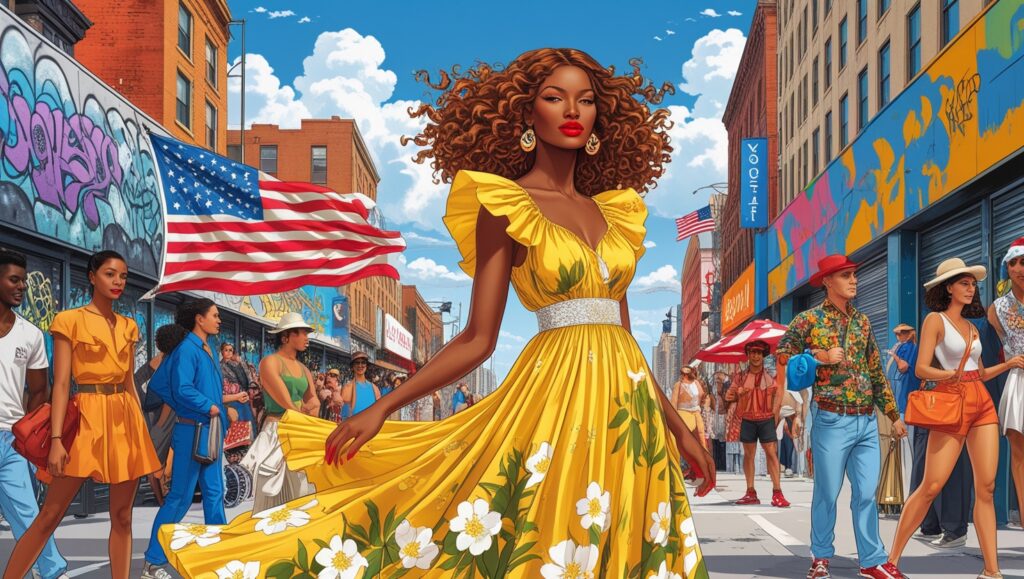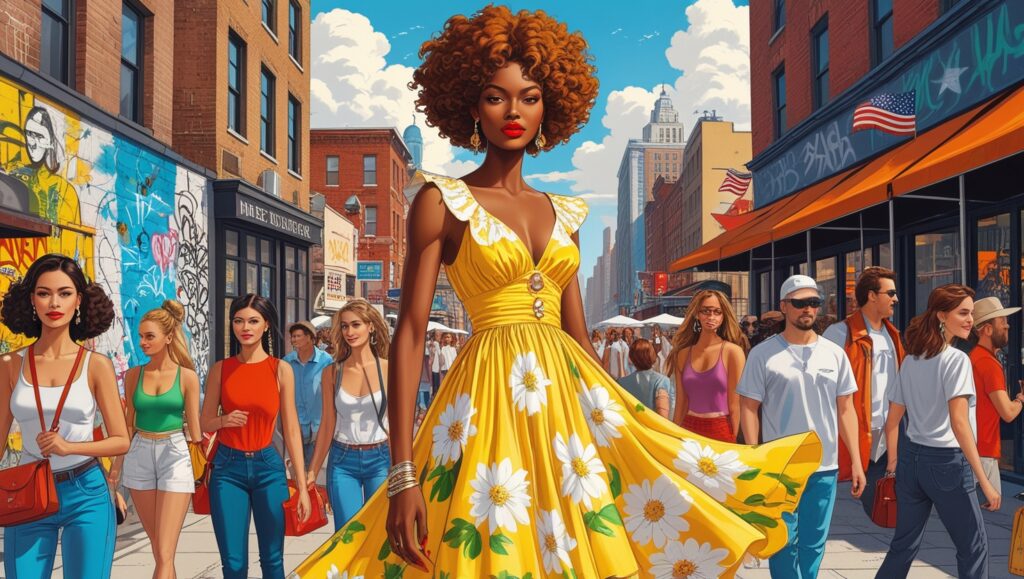
Introduction
US fashion is an ever-evolving tapestry. We weave it from history, culture, and innovation. It reflects many styles and trends. A mix of cultures, economic shifts, and global events influences them. From casual streetwear to high fashion, American fashion is as varied as the country. This article explores the complex world of fashion in the USA. It looks at its history, current trends, and cultural impact.
Historical Evolution of Fashion in the USA
Colonial and Early American Fashion
The fashion journey in the US began in colonial times. It was heavily influenced by European styles. Settlers from England, France, and Spain brought with them their clothing traditions. Men wore breeches, waistcoats, and frock coats. Women donned gowns with petticoats and stays, a precursor to corsets. The affluent used fabrics like wool, linen, and silk. The working class relied on simpler, sturdier materials.
During the Revolutionary War, fashion became a form of political expression. The homespun movement urged the use of local fabrics to protest British imports.
19th Century: Industrialisation and Westward Expansion
The 19th century saw major changes in American fashion. They were due to industrialisation and westward expansion. Mass production of textiles and garments made fashion more accessible. The sewing machine’s invention in the mid-1800s revolutionised garment production. It allowed for the rise of ready-to-wear clothing.

Styles during this period included:
Women: Corseted waists, voluminous skirts supported by crinolines and bustles.
Men: Tailored suits, waistcoats, and top hats for formal occasions.
Women: Corseted waists, voluminous skirts supported by crinolines and bustles.
Men: Tailored suits, waistcoats, and top hats for formal occasions.
The Gold Rush and westward expansion popularised rugged, functional clothing. This included denim jeans, introduced by Levi Strauss in 1873.
20th Century: The Birth of American Fashion Identity
The 20th century saw the emergence of a distinct American fashion identity:
1920s: The Roaring Twenties brought the flapper style. It featured short dresses, bobbed hair, and jazz-inspired accessories.
1940s: World War II brought utility fashion. It had functional designs and rationed fabrics.
The 1950s saw post-war prosperity. It gave rise to glamour, with cinched waists, full skirts, and tailored suits.
1960s and 1970s: Counterculture movements introduced bohemian styles, psychedelic prints, and unisex clothing.
1980s: Bold colours, power suits, and athletic wear dominated.
1990s: Minimalism and grunge defined the decade, with influences from hip-hop culture.
Key Influences on American Fashion
Cultural Diversity
The United States is a melting pot of cultures, and its fashion reflects this diversity. Immigrants have brought their traditional attire and skills. This has enriched American fashion. For example:
Latin Influence: Vibrant colours and intricate embroidery.
Asian influence: silk fabrics, kimono-inspired designs, and minimalist aesthetics.
African influence: bold prints, patterns, and accessories.

Entertainment Industry
Hollywood and the entertainment industry have had a profound impact on fashion trends. Icons like Marilyn Monroe, James Dean, and Audrey Hepburn set trends. They defined generations. Today, red-carpet events, music videos, and social media shape public style.
Technology and Innovation
Advancements in technology have transformed how fashion is designed, produced, and consumed. Digital tools enable designers to create intricate patterns and experiment with sustainable materials. E-commerce platforms and social media have made fashion accessible to a global audience.
Economic Factors
Economic conditions play a pivotal role in shaping fashion trends. During the Great Depression, practicality and affordability dictated clothing choices. Economic booms, such as those in the 1980s, featured extravagant fashions.
Contemporary fashion in the UK
Streetwear
Streetwear, rooted in skate and hip-hop culture, is now a top U.S. fashion trend. Brands like Supreme, Off-White, and Nike have popularised it. The style features graphic tees, oversized hoodies, and trainers.
Athleisure
Athleisure combines athletic wear with casual fashion. Yoga pants, leggings, and sneakers are no longer confined to gyms but are now staples of everyday wear. Brands like Lululemon and Adidas have capitalised on this trend.
Sustainable Fashion
With growing awareness of environmental issues, sustainable fashion has gained traction. American brands like Patagonia and Reformation prioritise eco-friendly materials and ethical production practices.
High fashion and luxury
The U.S. has some of the world’s top luxury brands and designers, like Michael Kors, Ralph Lauren, and Marc Jacobs. American designers often blend practicality with innovation. This creates a unique identity on the global fashion stage.
Digital Fashion and Influencers
Digital influencers and platforms like Instagram and TikTok have democratized fashion. Influencers showcase styles that resonate with younger audiences, driving trends in real time.
Regional styles in the USA
Northeast (New York, Boston)
The Northeast is a hub for business and high fashion. It’s known for its polished, sophisticated style. New York City is the US fashion capital. It hosts events like New York Fashion Week and is home to many designers and brands.
South (Texas, Louisiana)
Southern fashion often includes Western wear, like cowboy boots, hats, and denim. Bright colours and floral patterns are popular. They reflect the region’s warm climate and vibrant culture.
Midwest (Chicago, Kansas City)
The Midwest blends practicality with trendiness. Functional clothing for changing weather is common. So is a growing interest in sustainable and vintage fashion.
West Coast (California, Seattle)
The West Coast is synonymous with casual and laid-back styles. This region has a wide range of fashion. It spans from Silicon Valley’s tech-inspired minimalism to Hollywood’s glamorous red-carpet looks.
The Future of Fashion in the UK
Several key trends will shape the future of American fashion:
Sustainability
As consumers become more environmentally conscious, the demand for sustainable practices will grow. Circular fashion, biodegradable materials, and recycling initiatives are expected to dominate the industry.
Technology Integration
Fashion tech will redefine the way we make and sell clothes. This includes 3D printing, AI design, and virtual fitting rooms.
Inclusivity
Brands will focus on diversity and inclusivity. They will embrace a wider range of sizes, genders, and cultures.
Global Influence
American fashion will keep its unique identity. It will also draw inspiration from global trends, fostering cross-cultural collaborations.
Fashion can be categorised into various types based on style, purpose, and culture. Here are the main types of fashion:
- Haute Couture
High-end, custom-fitted clothing designed for individual clients.
Created by luxury fashion houses like Chanel, Dior, and Givenchy.
Often features intricate craftsmanship and exclusive fabrics.
- Ready-to-Wear (Prêt-à-Porter)
High-quality clothing produced in standard sizes for retail.
Designed by major fashion houses but more accessible than haute couture.
Found in upscale department stores and boutiques.
- Streetwear
Casual and trendy clothing inspired by urban culture and youth.
Often includes sneakers, graphic T-shirts, hoodies, and baggy jeans.
Popular brands include Supreme, Off-White, and A Bathing Ape.
- Casual Wear
Comfortable and functional clothing for everyday use.
Includes jeans, T-shirts, sweatpants, and sneakers.
- Formal Wear
Elegant attire for special occasions or business settings.
Includes suits, tuxedos, evening gowns, and cocktail dresses.
- Sportswear (activewear)
Designed for physical activities and sports.
Includes leggings, sports bras, tank tops, and trainers.
Brands like Nike, Adidas, and Lululemon dominate this category.
- Ethnic or Traditional Fashion
Represents cultural heritage and traditional attire.
Examples: Sarees and kurtas in India, kimonos in Japan, and kaftans in the Middle East.
- Vintage Fashion
Inspired by styles from previous decades.
It includes retro clothing, accessories, and patterns from the 1920s and 1980s.
- Bohemian (Boho) Fashion
Relaxed and artistic style inspired by hippie and gypsy cultures.
Features flowy fabrics, earthy tones, and ethnic prints.
- Gothic fashion
Dark and mysterious aesthetics.
Often features black clothing, leather, lace, and dramatic accessories.
- Preppy Fashion
Inspired by Ivy League college styles.
Includes polo shirts, blazers, chinos, and loafers.
- Minimalist Fashion
Simple and understated designs focus on neutral colours and clean lines.
Prioritises quality over quantity.
- Avant-Garde Fashion
Innovative and unconventional designs.
Often experimental and challenging traditional fashion norms.
- Fast Fashion
Manufacturers produce affordable and trendy clothing quickly to meet demand.
Examples: Zara, H&M, and Forever 21.
- Eco-Friendly (Sustainable) Fashion
Focuses on reducing environmental impact.
Uses recycled materials, organic fabrics, and ethical production practices.
- Luxury Fashion
High-end, premium-quality products made by designer brands.
Includes Louis Vuitton, Gucci, and Prada.
- Techwear
Combines functionality with style.
Features weatherproof fabrics, multi-pocket designs, and urban aesthetics.
- Business Wear
Professional attire for the workplace.
Includes blazers, tailored pants, pencil skirts, and dress shirts.
Fashion evolves, often blending elements from different types to create new styles.
Conclusion
Fashion in the USA is a reflection of the country’s dynamic and diverse character. American fashion, with its historical roots and trends, is a two-way street. It influences cultural shifts, technology, and global interactions. Those factors also influence it. Haute couture in the US shows the country’s ability to embrace global traditions and innovate. From Hollywood’s glamour to American designers’ craftsmanship, haute couture inspires. Despite challenges, tech, diversity, and sustainability can revive US haute couture. Haute couture is both an art form and a symbol of aspiration. It is vital to America’s fashion story. It celebrates individuality and the timeless appeal of craftsmanship.
